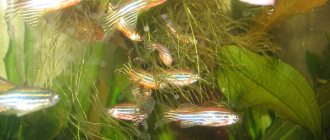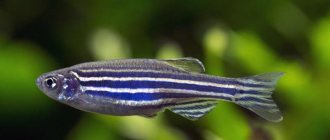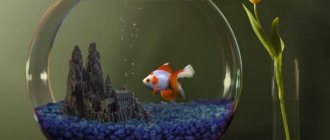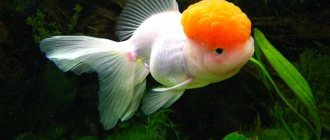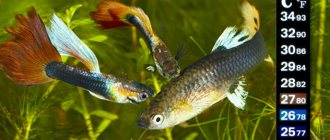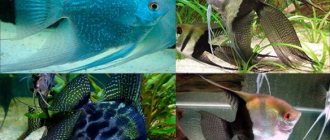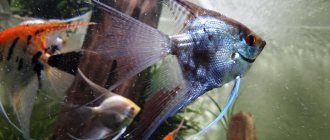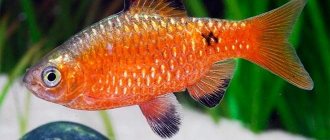What kind of fish is this?
Danio rerio (lat. Danio rerio) is a freshwater fish of the carp family of the genus zebrafish. Due to their beauty and lack of aggression, many species are popular in the aquarium hobby. In their natural environment, zebrafish can live both in small streams, canals and ponds, and in rivers .
The habitat depends on the time of year: during the rainy season, fish are localized in flooded rice fields and puddles, where they feed and reproduce, and at the end of the rainy season they return to rivers and large reservoirs.
The first mention of zebrafish dates back to 1822 , when they were discovered in rivers and streams on the east coast of India, Pakistan, Nepal, Myanmar and Bhutan. They came to us in 1905-1906 and were re-introduced to the USSR in 1950.
Appearance
The fish has a narrow, elongated body, the maximum length of which in aquarium conditions is 5-6 cm; its lips are decorated with pairs of mustaches.
The body from the gill covers to the fin is decorated with parallel stripes of yellow, yellow-green and black-blue.
How to distinguish between a male and a female?
Females have a larger and rounder body than males and wide stripes on the abdomen, tapering towards the tail and head. The body of males is shortened and thin with brighter luminescent stripes.
The anal fin in males is short and pointed, in females it is long and rounded.
How long do they live?
In the natural environment, zebrafish live for about 1 year , in aquariums - 3-4 years, the lifespan depends on the conditions of detention and care.
Danio rerio - interesting facts
The following information is currently known about these pets:
- The zebrafish is a schooling breed, so there should be at least two individuals in one aquarium.
- These are the only representatives of this species of animal that have visited an orbital station in space.
- During the rainy season, fish lay their eggs in flooded rice fields.
- The veiled form is considered to be the result of an artificial mutation of this breed; it does not exist in nature.
- A transgenic species called GloFish was bred in America. Their feature is glow in the dark. This was achieved by adding the jellyfish gene at the egg stage.
- People call fish “ladies' stockings.”
Types and their photos
The following is a description of the main types of zebrafish and photos of these fish.
Glofish
Glofish is a genetically modified species of rerio with a bright color. These fish have low requirements regarding food and care, but they live in warm water up to 28 °C.
Veiled
This variety differs from the main one in having a long pectoral fin and a bushy tail reaching 2 cm.
Red
A variety obtained by implanting a sea coral gene into the DNA of a fish.
When kept in an aquarium, it reaches 5 cm in length. Along the red body are darker stripes running from the gill valves to the caudal fin.
Pink
Small fish, the body length of which does not exceed 6 cm. The pink color alternates with white stripes located along the body. They feel comfortable in a container filled with stones, driftwood, floating plants, at a water temperature of 18-22 °C. The species appeared in Europe in 1911.
Blue
The length of the translucent body is no more than 4 cm, the color can be pale gray-blue with a golden tint or rich, the fins are green with a yellow tint. The belly is bluish in color with golden stripes along it, and the fins are translucent. Females, as a rule, are grayer in color, males are slimmer, their color is more intense.
Firefly
A bright orange-yellow fish, the body length of which is 3 cm. The tail fin is transparent in the middle with bright yellow outer rays. Females have a yellow fin on their back, while males have a red fin.
Description of zebrafish
Danio has an elegant, elongated body, his lips are decorated with pairs of mustaches. The maximum size of aquarium specimens is 6 cm, although larger fish are also found in nature. Experts have found that in the natural environment they live for about a year, but in aquarium conditions this period is 3-4 years.
The main tone of the body is pale yellow; against this background there are wide blue stripes that extend to the fins. There are many varieties of zebrafish that are amazing in their colors. But the fish that are most admired are those that have undergone genetic modifications; they are called GloFish.
Fluorescent elements were introduced into the genes of the fish, thus obtaining pink, green and orange zebrafish. The red tone comes from coral DNA, the green from jellyfish. And the yellow-orange shades were the result of the introduction of these two genes. The colors of GloFish zebrafish are bright and become much more intense under ultraviolet rays. Despite the unusual coloring, the individuals are practically no different from other representatives of the breed, neither in content nor in behavior.
In various sources you can come across information that genetically modified fish are sterile and that they are sterilized in order to prevent the spread of such individuals in natural bodies of water. However, these original representatives spawn, like ordinary fish, giving completely full-fledged offspring.
The Commission, which restricts the use of genetic technologies, vetoed the breeding, exchange and trade of fluorescent representatives of the breed. But in almost all pet markets you can find GloFish zebrafish.
Care and maintenance
Additional aeration is desirable, but it does not need to be installed, since zebrafish swim in the upper layers of water, where the amount of oxygen is maximum. For the same reason, the aquarium must always be covered, since in case of danger the fish can jump out of the water.
The volume of the aquarium depends on the number of fish: if you plan to keep 5 fish, a 20 liter aquarium is enough, if 10 or more, then the volume of the aquarium should be at least 35 liters.
Important! The aquarium should be long and narrow.
Daylight hours for an aquarium should last 10-12 hours; the rest of the time, artificial lighting is required at the rate of 0.5 W per 1 liter. water.
Small pebbles and gravel are used as soil. The preferred plants are Heleocharis, Vallisneria, Cabomba, Sagittaria and other long-leaved algae, which must be planted along the walls - a school of zebrafish should have an open area of the aquarium with good lighting for swimming.
Hardness – 5-15 dH, acidity – 6.0-7.5 pH.
Once every 1-2 weeks it is necessary to change the water - approximately 20-25% of the volume of the aquarium, in addition, a good filtration system is needed that sucks up leftover food and waste. After some time, bacteria will appear in the filter tube, enriching the water with the necessary microflora.
Temperature
The water temperature in summer should be 20-25°C, in winter – 17-21°C.
Keeping at home
Under comfortable and proper conditions, fish can live from two to six years, although they are quite easy to care for and will not cause any trouble to the owner. In one five-liter aquarium you can keep a flock of 5 fish, but you should take care of their safety and cover the container with a lid; very shy fish are capable of high jumps.
Water temperature requirements
Freshwater cyprinids in their natural habitat prefer to swim in the upper and middle layers of reservoirs, so for them the usual water temperature is 20-24 degrees, genetically modified ones will need to be heated to 28 0C.
List of requirements for aquarium water:
- Temperature is 20-24 degrees, some species are suitable for 15 or 28 degrees.
- Acid-base balance - 6.6−7.4.
- Water is added by 1/5 every week.
- A small part of the container is planted with useful plants, the individuals feed on them and lay eggs on them.
- Requires lighting and aeration.
Tiny zebrafish will not cause any trouble; keeping them in an aquarium is quite a simple and exciting activity, and besides, the fish easily coexist with other peaceful relatives. When placing plants, do not clutter the entire area; you need to leave free space for active play of the fry.
Diet and diet
In general, zebrafish are not picky in their maintenance and care and are suitable even for children and beginners, but in order for the pets to be healthy and active, the rules must be followed. For all living creatures on the planet, the key to health is proper and balanced nutrition, this also applies to fish.
The diet should be varied and harmoniously balanced, contain vitamins, microelements, fats and carbohydrates; all this can be found in dry fish food, but animals should not be denied either.
In nature, they feed on insects, larvae, eggs, tiny bloodworms, tubifex, brine shrimp and other small creatures - all this can be found in a special store and diversify dry feeding.
Surface fish never pick up food from the bottom , so you shouldn’t give too much food at one time, it will settle and clog the aquarium.
Feeding
Under natural conditions they feed on various insects, seeds and larvae; in an aquarium they eat any food, preferring to swallow it from the surface of the water.
Dry food contains useful macro- and microelements, vitamins and minerals, but you should not constantly feed it to the fish; you need to alternate dry food with live food : bloodworms, artemia, tubifex.
When using bloodworms as food for zebrafish, it is necessary to wash it in advance and soak it in a solution of potassium permanganate for several hours.
Food must be given 2-3 times a day in small portions, since fish of this species are prone to overeating, which can lead to various diseases, bloating and the accumulation of toxins, and uneaten food causes water oxidation and the proliferation of harmful microorganisms in it.
The most popular foods for zebrafish are General Duna, Tetra, Sera, Denerle.
Compatibility with other aquarium fish
With the correct selection of aquarium neighbors, the quality of life of zebrafish significantly improves and its duration increases.
The peaceful nature of zebrafish allows them to get along with almost all non-aggressive fish , for example:
- guppy;
- platies;
- mollies;
- tetras;
- swordtails;
- rasborami;
- minors;
- thorns;
- neon;
- cockroaches.
Zebrafish are incompatible with large, aggressive and slow fish, such as:
- acne;
- angelfish;
- koi carp;
- discus;
- astronotuses;
- cichlids.
It is better to keep zebrafish in small schools of 10-15 individuals, where a clear hierarchy will be observed, and the entire family will be able to cope more easily with stressful situations.
Reproduction
Female zebrafish are not viviparous; they lay eggs, which are then fertilized by the male.
Spawning occurs in a separate container . This can be a small (10-15 liters) volume aquarium or, in extreme cases, a three-liter jar.
Place fontinalis or peristolium on the bottom, pressing down the algae with small stones so that they do not rise, and pour in fresh water, standing for at least 48 hours, the temperature of which is 23-26 °C. The water level above the algae should rise by 5-7 cm.
It is necessary to place a pregnant female and several males in a prepared tank 7-10 days before spawning. This should be done in the evening and in the morning the female will begin to lay eggs, producing 50-400 eggs at a time.
Reference! If spawning has not begun in the morning, it is necessary to leave the spawners in the spawning tank for another day, generously feeding them with live bloodworms and daphnia.
Once the process is complete, the spawners should be returned to the main tank and half of the water in the spawning tank replaced with fresh water. After 3-4 days, larvae appear from the eggs and settle on the walls of the tank; after a few days, fry appear, which must be fed with rotifers or ciliates.
As the fry grow, you need to change their diet and after 20-30 days give them cyclops, daphnia or bloodworms. Over time, they need to be transplanted into a larger tank and fed like adult fish.
Diseases
In general, zebrafish have fairly good health and resistance to disease, which is one of the reasons for the popularity of this type of fish. However, if the conditions of detention are not observed, they may be susceptible to certain diseases.
Tuberculosis
This is an infectious disease that enters the aquarium with soil, algae or other infected fish. The fish become lethargic, lose their appetite, and scales fall out.
Tuberculosis can be cured only in the early stages of the disease . The main medicine is kanimycin, it must be mixed with food in equal parts.
Important! The infected fish must be kept in a separate container with water, and at the end of treatment, regardless of its outcome, a general cleaning of the general aquarium and disinfection of decorative elements is required.
Bug-eyed
The most common disease in zebrafish that occurs due to unsatisfactory water quality.
Fish get sick during spawning , and the occurrence of symptoms is often not monitored, since the main one is an enlarged abdomen, which can be mistaken for a sign of pregnancy.
After a few weeks, a more serious symptom becomes noticeable - the fish’s eyes bulge and eventually fall out, which causes death.
Alkalosis
Alkalosis, or alkaline disease, occurs as a result of an imbalance in the acid-base balance of water. If the fish often jump out of the water, itch against the walls of the aquarium or its bottom, and their skin turns pale, these are signs of alkalosis.
To fix the problem, you need to install a pH buffer that maintains the acidity of the water at the required level.
Growths on the body
This problem occurs quite rarely and when it occurs, it is necessary to transfer the fish from the general aquarium to a separate container for quarantine, where the water temperature is 28 °C, to use salt baths.
Trichondiasis
This is an infectious disease caused by Trichodina ciliates, which occurs due to insufficient disinfection of objects placed in the aquarium. If a fish gets trichondiosis, it rubs against the walls of the aquarium, the shade of its skin changes to a paler one, and a dirty coating can be seen on its body.
It is necessary to increase the water temperature to 30 °C and take baths with trypaflavin or table salt.
Diseases of aquarium fish zebrafish
When you create the right habitat in the aquarium, the fish will not get sick. Otherwise, various health problems may arise. Diseases of zebrafish can be as follows:
Ichthyophthyriosis. A white rash appears on the body, which is called “semolina”. The fish's fins are compressed and they constantly itch against all available objects. The reason is the isociliated ciliate, which ends up in an aquarium with bad food or new inhabitants. Therapy: use organic malachite dye at a concentration of 0.9 mg/l. It is added every day until complete cure, replacing 1/4 of the water.
Plistophorosis. Symptoms are white spots that develop into ulcers. The fish and plants are transplanted, and the aquarium is disinfected with a 5% solution of hydrochloric acid. Treatment – Erythrocycline (50 ml/1 l of water) and Trichopolum (5 mg/1 l of water).
Trichonodiasis. Symptoms: the body becomes covered with a gray coating. The cause is the ciliate Trichodina. Therapy – raising the water temperature to +31°C. Add a solution of table salt to the aquarium (1 tablespoon/1 liter of water).
Bug-eyed. Symptoms include bulging and clouding of the eyes. The reason is water pollution in the aquarium.
It is important to change the water and clean the aquarium thoroughly.
Where to buy and what to look for?
When purchasing, you need to examine the skin of the fish and make sure that there are no signs of disease or mechanical damage on the body and fins.
Important! The fish may look too pale as a result of being frightened by the hand-to-hand transfer process.
After purchasing, you should place the zebrafish in a separate container to ensure its health.
The cost of fish depends on the rarity of the species . Common varieties of zebrafish cost from 35 rubles, fluorescent ones – from 45 rubles, and firefly zebrafish – from 137 rubles. per copy.
